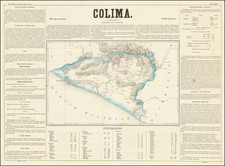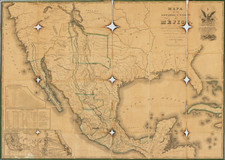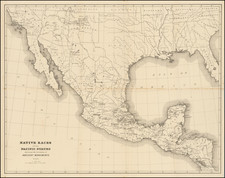Aztec Astronomical Pictograms: Eclipse and Earthquake
From the Codex Telleriano-Remensis
A beautiful 19th-century watercolor of pictograms relating to aspects of Aztec cosmogony. Specifically, we see here the pictograms for a solar eclipse and another for earthquakes. The present ink and watercolor drawing executed by Captain William H. Shippard, a significant but overlooked pioneer researcher of early Mexican civilizations. These images were copied from the noted Codex Telleriano-Remensis, a Mexican codex housed in the Bibliotheque Nacional de France.
The solar eclipse is an elegant and refined representation of straight-forward visual iconography: the sun depicted against a blue sky with white stars, as a black sphere moves into the scene just beginning to obscure the sun, all inscribed within a flag-like rectangular framing.
Nahui Olin
The earthquake pictogram is indicated here by no. 5. Referred to as nahui-ollin in Nahuatl, earthquakes are represented in Aztec pictograms by two symbols: ollin (movement) and tlalli (Earth).
Carmen Mondragon, a noted early 20th-century Mexican artist and model, adopted the name Nahui Olin, which was given her by one of her lovers, the painter and volcanologist, Geraldo Murillo, who was also known as Dr. Atl. Noted for her mesmerizing beauty, Nahui Olin modeled for several important artists, including Diego Rivera and the American photographer, Edward Weston. A series of nude photographs of her by Antonio Garduño is well known. Her own paintings have recently received some attention through exhibitions and publications, mainly in Mexico.
The remaining figures relate to various aspects of Aztec-Mexica cosmogony.
The watercolor is signed by Shippard and dated 16 October 1834.
Shippard's caption reflects his deep interest in early Mexican civilizations:
... from the method adopted in the Representation here De Humboldt concludes they were acquainted with the true causes of Eclipses. This Painting is therefore both important and curious, tending to prove some sort of advance in their knowledge of Astronomy. That they watched the courses of the Heavens night and day is proved by page 64 of the Mendoza Collection representing a Priest (whose occupation it was) watching the Heavens by night and counting time, which plate refers to an earlier stage of their knowledge. I have also a facsimile of No. 44 Lithograph 13 of Dupaix's Monuments of New Spain at being a stone on which is cut the figure of a man holding up a tube or optical instrument of some sort to study the Heavens, Lord Kingsborough seems inclined to believe they knew the telescope but he must mean mere hollow tubes such as those used formerly by Philosophers prior to the invention of the telescope. No. 5 means an Earthquake [i.e. Nahui Ollin].
This lower page records a very great fall of snow which took place in the year ___ shown on the square tablet. The death of a native Chief, Prince, or Governor and the crowning of his successor is also pictured here. W. H., Shippard, 16 Oct. 1834.
William Henry Shippard's Mexican Paintings
William H. Shippard (1803-1865) was a pioneering 19th-century British museologist - an unsung progenitor of modern-day museum anthropology. While he is chiefly remembered as a friend of George Catlin, Shippard's profound interest in the ancient civilizations of Mexico connects him with a cohort of British contemporaries that include Lord Kingsborough and the showman William Bullock. Shippard's fascination with Mesoamerica propelled him to amass a significant collection of visual material derived from Aztec codices which he copied himself. A figure of some intrigue and scholarly ambition, Shippard endeavored to establish the Museum of Mankind in London, which seems to have evolved from his deep interest in early Mexican cultures. Although the museum did not come to fruition, Shippard's original artwork, mainly pen and ink drawings enriched with vibrant hand coloring, based on Mexican codices held in European libraries and collections, remains a valuable historical source, particularly for understanding the allure of Mexican antiquity within early 19th-century British collecting circles.
Capt. William H. Shippard, a friend of George Catlin and an avid watercolorist and museologist, was also a pioneering British Mesoamericanist. Shippard appears in British newspaper notices from the 1840s as a London-based lecturer who spoke about Native Americans and Mexican antiquities. We know he was a friend of George Catlin, and that he was involved in attempts to organize early London museum exhibitions of Mexican antiquities. In the latter efforts Shippard would seem to coincide with a group of like minded prominent English collectors interested in Mexican topics active during the 1820s and 1830s, including Lord Kingsborough and the bibliomaniac Sir Thomas Phillipps, among others. He seems to have been an armchair anthropologist and would-be museum founder, whose ambitious ideas for a London-based museum never got off the ground - at least not beyond the prospectus-printing stage. Certain aspects of Shippard's career are akin to William Bullock, the showman and connoisseur of Mexican antiquities who actually did travel to Mexico. Bullock published a notable book about his Mexican travels, and achieved a level of recognition in his day as the empresario of London's Egyptian Hall, wherein he thrilled large London audiences with his elaborate exhibitions of exotica, including Mexican items.









![[ Virginia Natives ] Fictilium Vasorum In Quibus Cibum Coquunt Forma XV [Their Seething of Their Meat in Earthen Pots]](https://storage.googleapis.com/raremaps/img/small/98700.jpg)



![[Original photograph:] Native American group image, possibly in Indian Territory, with White Settlers](https://storage.googleapis.com/raremaps/img/small/82871.jpg)
